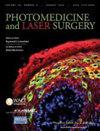Joelita de Alencar Fonseca Santos, Mariana Barbosa Dias Campelo, Rauirys Alencar de Oliveira, Renata Amadei Nicolau, Verônica Elis Araújo Rezende, Emilia Ângela Loschiavo Arisawa
下载PDF
{"title":"低功率光治疗对糖尿病足慢性创伤组织修复过程的影响。","authors":"Joelita de Alencar Fonseca Santos, Mariana Barbosa Dias Campelo, Rauirys Alencar de Oliveira, Renata Amadei Nicolau, Verônica Elis Araújo Rezende, Emilia Ângela Loschiavo Arisawa","doi":"10.1089/pho.2018.4455","DOIUrl":null,"url":null,"abstract":"<p><strong>Objective: </strong>To analyze the efficacy of the therapeutic use of Low-Level Laser Therapy (LLLT) on the tissue repair process of chronic wounds in patients with diabetic feet through the analysis of Pressure Ulcer Scale for Healing (PUSH) scales, pain and the measurement done using the ImageJ<sup>©</sup> software.</p><p><strong>Methods: </strong>This clinical trial was carried out with 18 patients 30-59 years of age, who had chronic wounds on their foot due to complications of diabetes mellitus. The patients were randomly allocated in two different groups of equal numbers: Control and Laser Groups. The LLLT equipment used in the research has a wavelength of 660 nm, 30 mW power, continuous mode emission, 6 J/cm<sup>2</sup> dosimetry, 48/48 h in a 4-week period. Measurement and the aspect of wounds were noted in the PUSH scale and the pain was evaluated weekly. The Mann-Whitney U nonparametric test was used to compare groups.</p><p><strong>Results: </strong>The Laser Group presented a significant increase of the tissue repair index when compared with the Control Group, with a significant statistical difference (p < 0.013). There was no significant difference between the groups in all the weeks using the PUSH scale.</p><p><strong>Conclusions: </strong>The use of LLLT on chronic wounds in a diabetic foot demonstrated efficacy on the progression of the tissue repair process in a short period.</p>","PeriodicalId":20117,"journal":{"name":"Photomedicine and laser surgery","volume":"36 6","pages":"298-304"},"PeriodicalIF":0.0000,"publicationDate":"2018-06-01","publicationTypes":"Journal Article","fieldsOfStudy":null,"isOpenAccess":false,"openAccessPdf":"https://sci-hub-pdf.com/10.1089/pho.2018.4455","citationCount":"39","resultStr":"{\"title\":\"Effects of Low-Power Light Therapy on the Tissue Repair Process of Chronic Wounds in Diabetic Feet.\",\"authors\":\"Joelita de Alencar Fonseca Santos, Mariana Barbosa Dias Campelo, Rauirys Alencar de Oliveira, Renata Amadei Nicolau, Verônica Elis Araújo Rezende, Emilia Ângela Loschiavo Arisawa\",\"doi\":\"10.1089/pho.2018.4455\",\"DOIUrl\":null,\"url\":null,\"abstract\":\"<p><strong>Objective: </strong>To analyze the efficacy of the therapeutic use of Low-Level Laser Therapy (LLLT) on the tissue repair process of chronic wounds in patients with diabetic feet through the analysis of Pressure Ulcer Scale for Healing (PUSH) scales, pain and the measurement done using the ImageJ<sup>©</sup> software.</p><p><strong>Methods: </strong>This clinical trial was carried out with 18 patients 30-59 years of age, who had chronic wounds on their foot due to complications of diabetes mellitus. The patients were randomly allocated in two different groups of equal numbers: Control and Laser Groups. The LLLT equipment used in the research has a wavelength of 660 nm, 30 mW power, continuous mode emission, 6 J/cm<sup>2</sup> dosimetry, 48/48 h in a 4-week period. Measurement and the aspect of wounds were noted in the PUSH scale and the pain was evaluated weekly. The Mann-Whitney U nonparametric test was used to compare groups.</p><p><strong>Results: </strong>The Laser Group presented a significant increase of the tissue repair index when compared with the Control Group, with a significant statistical difference (p < 0.013). There was no significant difference between the groups in all the weeks using the PUSH scale.</p><p><strong>Conclusions: </strong>The use of LLLT on chronic wounds in a diabetic foot demonstrated efficacy on the progression of the tissue repair process in a short period.</p>\",\"PeriodicalId\":20117,\"journal\":{\"name\":\"Photomedicine and laser surgery\",\"volume\":\"36 6\",\"pages\":\"298-304\"},\"PeriodicalIF\":0.0000,\"publicationDate\":\"2018-06-01\",\"publicationTypes\":\"Journal Article\",\"fieldsOfStudy\":null,\"isOpenAccess\":false,\"openAccessPdf\":\"https://sci-hub-pdf.com/10.1089/pho.2018.4455\",\"citationCount\":\"39\",\"resultStr\":null,\"platform\":\"Semanticscholar\",\"paperid\":null,\"PeriodicalName\":\"Photomedicine and laser surgery\",\"FirstCategoryId\":\"1085\",\"ListUrlMain\":\"https://doi.org/10.1089/pho.2018.4455\",\"RegionNum\":0,\"RegionCategory\":null,\"ArticlePicture\":[],\"TitleCN\":null,\"AbstractTextCN\":null,\"PMCID\":null,\"EPubDate\":\"\",\"PubModel\":\"\",\"JCR\":\"Q2\",\"JCRName\":\"Medicine\",\"Score\":null,\"Total\":0}","platform":"Semanticscholar","paperid":null,"PeriodicalName":"Photomedicine and laser surgery","FirstCategoryId":"1085","ListUrlMain":"https://doi.org/10.1089/pho.2018.4455","RegionNum":0,"RegionCategory":null,"ArticlePicture":[],"TitleCN":null,"AbstractTextCN":null,"PMCID":null,"EPubDate":"","PubModel":"","JCR":"Q2","JCRName":"Medicine","Score":null,"Total":0}
引用次数: 39
引用
批量引用
Effects of Low-Power Light Therapy on the Tissue Repair Process of Chronic Wounds in Diabetic Feet.
Objective: To analyze the efficacy of the therapeutic use of Low-Level Laser Therapy (LLLT) on the tissue repair process of chronic wounds in patients with diabetic feet through the analysis of Pressure Ulcer Scale for Healing (PUSH) scales, pain and the measurement done using the ImageJ© software.
Methods: This clinical trial was carried out with 18 patients 30-59 years of age, who had chronic wounds on their foot due to complications of diabetes mellitus. The patients were randomly allocated in two different groups of equal numbers: Control and Laser Groups. The LLLT equipment used in the research has a wavelength of 660 nm, 30 mW power, continuous mode emission, 6 J/cm2 dosimetry, 48/48 h in a 4-week period. Measurement and the aspect of wounds were noted in the PUSH scale and the pain was evaluated weekly. The Mann-Whitney U nonparametric test was used to compare groups.
Results: The Laser Group presented a significant increase of the tissue repair index when compared with the Control Group, with a significant statistical difference (p < 0.013). There was no significant difference between the groups in all the weeks using the PUSH scale.
Conclusions: The use of LLLT on chronic wounds in a diabetic foot demonstrated efficacy on the progression of the tissue repair process in a short period.

 求助内容:
求助内容: 应助结果提醒方式:
应助结果提醒方式:


